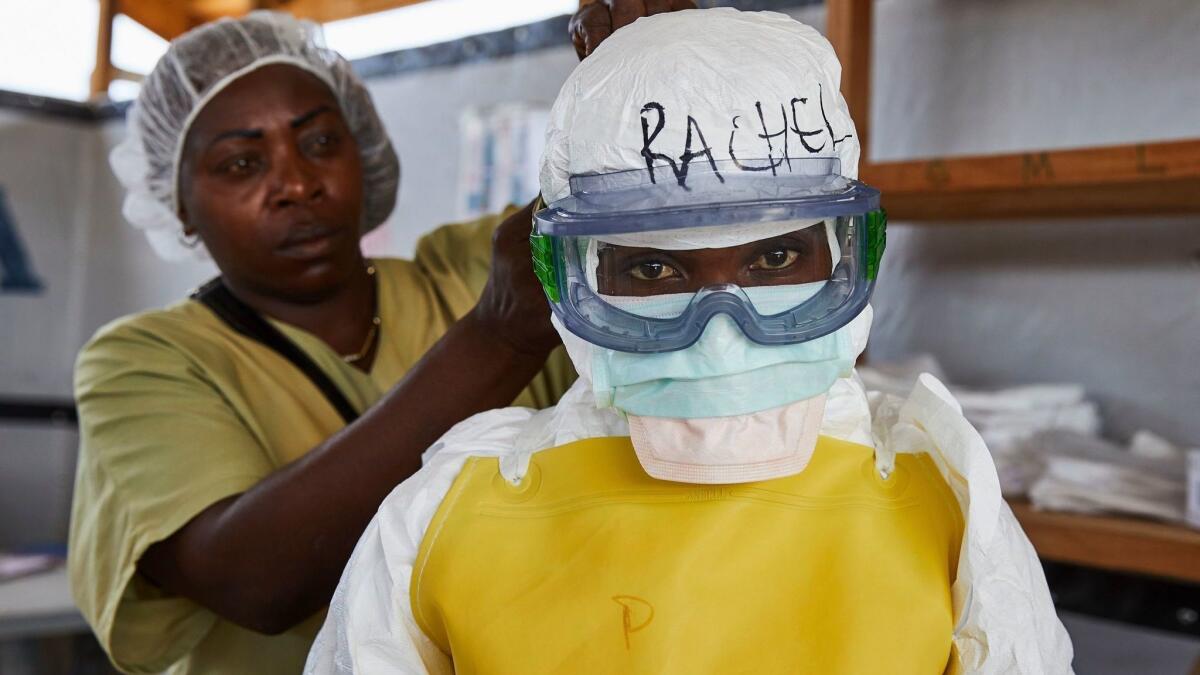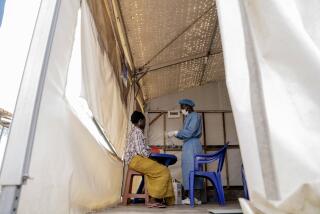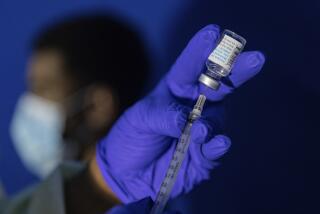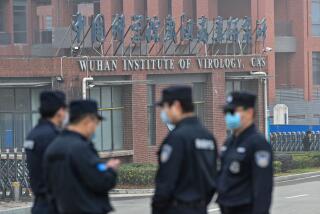As Ebola outbreak rages, the world just watches. Some call it âmalignant neglectâ

The Ebola outbreak raging through Congo has sickened thousands of people and killed more than 1,500 â even as the number of new victims continues to climb.
The situation is dire, but itâs hardly unprecedented. Less than five years ago, an epidemic in West Africa killed more than 11,000 people, shattering communities, destroying economies and leaving a generation of orphans behind.
When it was over, world leaders took a solemn vow: Never again. Health officials studied the failures of their sluggish and haphazard response so they would recognize the warning signs of a crisis not to be ignored.
That crisis is now here. Yet with Ebola spreading eastward into Uganda, epidemiologists and aid groups are dismayed by the many indications that the pledge has been forgotten.
The World Health Organization spent months begging for the $98 million it says it needs to set up temporary health clinics and distribute vaccines that could stop the virus in its tracks. The Trump administration has banned Ebola experts from the Centers for Disease Control and Prevention from entering the hot zone. And a WHO committee has turned down three chances to declare the outbreak a global health emergency, taking pressure off of high-income countries to intervene before transmission seeps into South Sudanâs refugee camps and explodes.
âCould we be repeating the same mistake we made in West Africa? Absolutely,â said Lawrence O. Gostin, who directs the OâNeill Institute for National and Global Health Law and served on several review commissions following the epidemic that ended in 2016.
âIâm bewildered, and deeply troubled,â he said. âWeâre seeing a steady drumbeat of death â which could boil over into a full-blown epidemic. We know better than this.â
The Ebola virus, which causes a highly lethal hemorrhagic fever, spreads from person to person through infected blood, vomit and sweat. It causes leaky blood vessels and circulatory failure, which starves the bodyâs organs of oxygen â leading to shock and multiple organ failure. Its symptoms, including uncontrolled vomiting and diarrhea, can cause fatal dehydration even before the infection wins out.
Already, the WHO says the year-old outbreak has killed 1,586 people, making it the second largest in history. It is expected to last at least another year.
And itâs spreading. In June, a five-year-old Ugandan boy contracted the virus in the Democratic Republic of Congo while visiting his grandfather, who died of Ebola in late May. The boy and several family members who were showing symptoms crossed back into Uganda, where they are believed to have had contact with at least 98 people. The five-year-old was the first of them to die.
Yet the world seems unable to take the steps that worked the last time around.
During the West African epidemic, it was the global outpouring of funds and personnel that allowed Liberia, Guinea and Sierra Leone to squelch the outbreak. The United States committed $3.7 billion and sent troops to the region to ratchet up the response. Several European countries followed suit.
This time, the U.S. and other key global powers are mostly watching from the sidelines. The U.S. Agency for International Development has been sending money to Congo since the outbreak began, according to spokesman Tom Babington, but it wasnât until this week that the agency said it had increased its investment to $98 million to fund activities like patient care and infection control. And the State Department wonât allow the CDCâs medical workers â the worldâs most seasoned interventionists â to go to the region, citing concerns about their safety.
Those concerns are well-founded: The outbreak is centered in North Kivu and Ituri, heavily populated provinces marked by decades of political instability and violent conflict. As many as 134 separate armed rebel groups have sparred for control of the mineral-rich region in recent years, and an explosion of ethnically motivated kidnappings, maimings and sexual violence displaced at least 300,000 people in June alone, according to the United Nations.
âThe complexity of the environment in North Kivu is unparalleled,â said Juliet Bedford, an Oxford University anthropologist who studied the community dynamics of both outbreaks.
In the hot zone, Ebola response teams are caught in the crossfire. Insurgents have launched more than 150 attacks on health workers so far this year, killing five and injuring about 50 others. Doctors Without Borders, usually a primary player in disease outbreaks, shut down its treatment centers after multiple attacks in February.
Each violent uprising is followed by a surge of new infections as aid workers lose vital ground.
Still, dozens of CDC officials have battled hemorrhagic fevers in violent regions before, and some are eager to get to work in Congo, according to Jennifer Kates, an expert on U.S. global health policy at the Kaiser Family Foundation.
âThere are U.S. personnel who believe they have the expertise to help, and theyâre not able to go,â Kates said. âItâs coming up again and again.â
Others have noted that contractors for the U.S. Agency for International Development are currently operating in the line of fire.
âThere are some inconsistencies in our security posture,â said Jennifer Nuzzo, an epidemiologist at the Johns Hopkins Center for Health Security.
A spokesman for the National Security Council declined to discuss the situation on the record.
The WHO committeeâs reluctance to declare a global emergency deprives the CDC of the leverage it needs to convince the Trump administration to let its specialists join the front lines.
âHigh-income countries fear a Benghazi moment: If they let trained experts into the hot zone and they got killed â or worse, kidnapped â it would be a political crisis,â Gostin said. âTheyâre gun-shy.â
In the West African outbreak, local health workers meticulously tracked down and isolated each patientâs potential contacts, essentially snipping each strand of the outbreakâs expanding web.
Thatâs not happening this time. It simply doesnât work in a humanitarian crisis, particularly one marked by a deep-rooted suspicion of authority and huge numbers of people on the move. At least 4.5 million Congolese have been displaced from their homes and neglected by the central government â breeding distrust in the very figures who are now leading the Ebola response.
Conspiracy theories about Ebola swirl on social media. Some say itâs a biological attack by white Westerners; others say it was spread by the Congolese government. More than a quarter of North Kivu residents donât believe the virus is real, according to a recent report in the medical journal Lancet.
âTheyâve been attacked and killed by various things for ages, and no one did anything before. Theyâre thinking, âNow, Ebola is here and everyone wants to save us? Yeah, right,ââ said Dr. Marta Lado, chief medical officer of Partners in Health in Sierra Leone, who has worked on the ground in both Ebola outbreaks.
The result is that less than one-third of all confirmed cases have been linked back to known contacts, and more than 80% of new cases have not been followed, according to Doctors Without Borders. On a map, the outbreak pattern is made up of erratic clusters throughout the region rather than a cohesive web of cases.
It also means the total case count is likely much higher than the official figures reported by the WHO, the medical aid group says.
The lack of trust also undermines the value of an experimental Ebola vaccine developed by Merck. The vaccine is more than 95% effective, but health workers canât identify the people most at risk of contracting the virus since families are hiding infected loved ones behind closed doors for fear that they will be hauled away.
With a vaccine shortage looming, experts have debated whether to dilute the remaining doses so they can be spread among more people as the outbreak grows. But the drug is so new that scientists arenât sure it would remain effective.
In 2014, the WHOâs decision to declare the outbreak a public health emergency of international concern â or PHEIC â came less than five months after the virus was detected. At that point, there had been fewer than 1,000 deaths.
In the current outbreak, the WHOâs emergency committee debated the issue three times â in October, April and just last month â as the outbreak enters its second year.
Preben Aavitsland, the emergency committeeâs acting chair, said that the group spent a great deal of time debating the âpossible unintended consequences of such a declaration,â such as more targeted attacks on aid workers. They concluded that âthe ongoing response would not be enhanced by formal temporary recommendations from WHO.â
For example, a declaration could inadvertently provoke travel bans, visa cancellations and trade freezes, which would further devastate the fragile regionâs economy while making health workersâ jobs more difficult. International health regulations forbid such actions, but they happen anyway. Fifty-eight countries restricted travel from West Africa during the 2014-2016 epidemic, and several airlines ceased flights to and from the region.
As a private citizen during the West Africa outbreak, Donald Trump spoke in favor of isolating affected countries and preventing medical volunteers from returning to the U.S., leaving doctors and nurses to âsuffer the consequences.â However, research shows that travel restrictions during epidemics are ultimately detrimental, keeping healthcare workers and vital supplies from reaching the region to contain the outbreak.
Research also suggests that the decision to declare a global emergency is often influenced by an outbreakâs degree of impact on the United States. In 2014, the PHEIC designation came just six days after infected health workers first arrived in the United States.
âItâs not benign neglect â itâs malignant neglect,â Gostin said. âWe irrationally lurch between complacency and crisis mode â underreacting when thousands of Africans are dying, but panicking when a single case arrives in North America or Europe. That mindset is unforgivable.â







